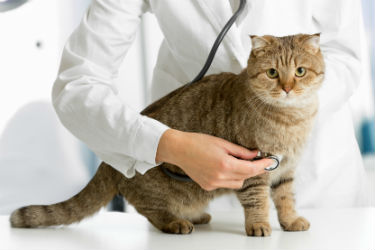Veterinarian Tips: Choosing an Adult Cat

When a client is planning to adopt an adult cat, advise them to consider the answers to the following questions before they begin their search for their new family pet!
#1. How much time do I have to dedicate to this animal?
If the family calendar is filled with work and activities, adopting an adult cat can be a very good choice as this new family pet won’t require as much human interaction for playtime or training! However, it is important that clients understand that they do still need to take time to spend with the animal. The amount of time, however, is what needs to be determined. Consider, for example:
- A cat that craves attention, is playful, loving, or who wants to be a lap cat will require more time as they are one that needs to have their family present
- If the family is on the go and often away from home, would one that is more content to be by itself be the better choice?
One other time factor to think about includes, for instance, the animal’s grooming needs. Even though cats self-groom and keep themselves relatively clean, it is still recommended to set aside time and establish a routine dedicated for the animal’s grooming needs. Regular grooming is necessary to:
- Reduce the amount of hair that is shed in the home
- Lessen the cat’s chance of forming hairballs by removing hair that would otherwise be licked off and swallowed as the animal self-grooms
- Help older animals with diminished flexibility by grooming the spots they can no longer reach
- Provide an opportunity to watch for:
- Any developing changes of the cat’s skin and coat which could indicate a health condition
- Fleas or other parasites such as mites and ticks that require insecticide or veterinary attention
- Keep the coat of a long-haired cat free of mats and tangles
- A badly groomed coat of a long-haired cat can become painful, and if not attended, the animal may need to be sedated and shaved by an animal groomer.
Consideration needs to be given to the amount of time that an individual cat will require to keep its coat and skin healthy and clean. This information may change the decision from adopting a short-haired versus a long-haired cat.
#2. What is my family looking for in a pet cat?
When thinking of the type of cat that will best fit in with the family, it is also important to keep in mind that the animal’s breed may influence its behavior and temperament. A plus for adopting an adult cat is that its breed may be very apparent. When so, clients should be able to gather some information that will suggest what living with the animal may be like. Advise clients to take the time to research the different cat breeds to learn more about the cats’:
- Personality. Certain breeds have a tendency to be:
- Very vocal
- Fond of high spaces and will climb and jump on top of cabinets, tables, etc.
- Even tempered, calm, and quiet
- Energetic, athletic, and very active
- Gentle, good with children
- Bossy and demanding
- Possessive of “their” person
- Intolerant of other animals or of some types of human attention
- Potential for health issues. For instance, some breeds have a proclivity for:
- Misaligned teeth
- Difficulty breathing
- Dry eyes and corneal ulcers
- Trouble self-grooming
- Heart disease
- Joint issues
- Digestive issues.
If a client is new to owning a cat, they may not realize that cats are uniquely different with individual personalities. Advise clients that before they make the final decision to bring an animal home, they get to know the cat by following these steps:
- Watch the cat’s reaction:
- See if it is interested in meeting you
- Does it come to you, look at you, try to smell and rub its face or body on you
- Does it look away as if it hopes it isn’t seen or doesn’t want to be bothered
- Try to spend some time with the animal in a quiet place where it can relax and show its personality:
- Let the animal come to you
- Remind clients to be patient as cats are cautious animals when in new environments or when around unfamiliar people
- Watch the cat’s reaction to being:
- Petted
- Some cats love being petted, others not so much
- Picked up
- Does it seem content to be picked up and held, does it quietly struggle to get down, or does it resist and fight against being picked up?
- Around children
- Is the animal interested in being around them, does it calmly move away, or is it determined to get away and stay away from them?
- Petted
One Final Tip to Share: Once the decision is made and the animal is brought to its new home, offer clients the following advice:
- Even though you are excited to welcome the animal to your home, the cat may feel anxious and scared
- Show patience by giving it space, and allowing it time to adjust.
Cats often live for an average of 15 years, and some live into their twenties! That’s a lot of time to give a lot of love!
Sources:Cat Owner’s Home Veterinary Handbook, D. Eldredge, D. Carlson, L. Carlson, J. Giffin, 2008, Wiley Publishing Co.
http://pets.webmd.com/cats/guide/what-to-do-about-hairballs-in-cats
Careers
Are you looking for a place to let your talents shine? At Covetrus, we help our practitioner customers better serve their patients and take pride in providing the best customer experience possible. Search our open positions to see our available opportunities.
Newsletter
Stay current with what’s going on with Covetrus, subscribe to receive our newsletter and email communications. Subscribers will receive the latest information in practice management, sales and marketing, animal health, and more.


Leave a comment